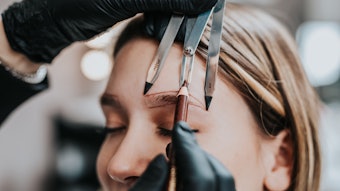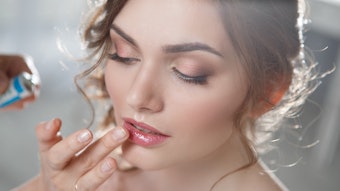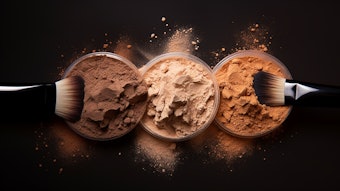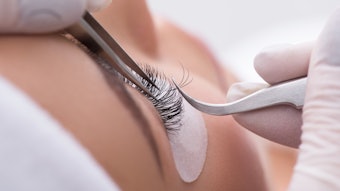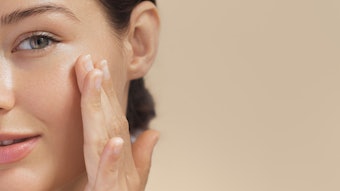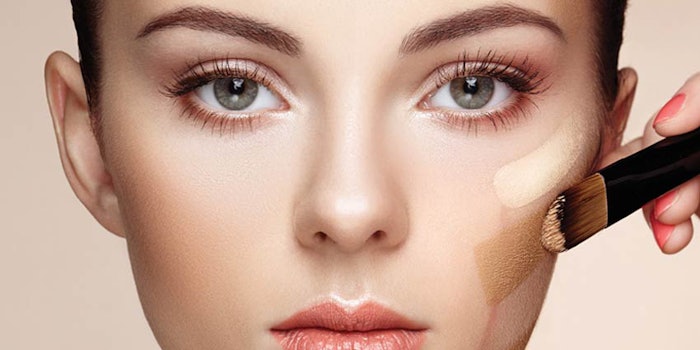
After a surgical procedure, particularly on the face, traditional cosmetics do not always cover it—literally. This need gives way to camouflage makeup, which helps patients return to their everyday life and routine post-procedure. Camouflage products cannot alter the structure of the skin, but the immediate visual effect will help improve self-esteem. It can also be helpful for individuals challenged with other disfigurements such as dermatological disorders and congenital conditions.
There are three considerations to keep in mind when using camouflage to correct the skin: counteract, cover and create.
A customized camouflage makeup application allows the makeup specialist to create any type, color, texture, finish and coverage that can meet the needs of any client, regardless of their age, gender, dermatological condition or surgical procedure. The goal with a camouflage makeup treatment is to improve the appearance of the skin to the point that the focus is no longer on the skin defect or discoloration.
Consult First
A consultation with a client/patient prior to a medical makeup application is important to understand the client expectations, to test acceptable color matches and to advise the client on what is best suited for their skin condition and lifestyle. A consultation can take approximately one hour to answer all of the client’s questions and an discuss the appropriate camouflage application plan. During this time, it is important to understand the client’s Indications for Medical Makeup as outlined, to develop the right strategy. Also, the technician must communicate realistic expectations as described below.
Expectations of Post-Surgical Makeup
- Enhance the patient’s self-image.
- Help patients return to normal functioning public life.
- Conceal complexion irregularities and disfigurements.
- Create normalcy rather than beautification.
Always get post-surgical approval from a medical practitioner on the appropriate time to use skin camouflage after a surgical procedure. Camouflage makeup should not be used in the event of:
- Open sores or wounds;
- Bleeding at the incision site;
- Signs or symptoms of infection (heat, redness, swelling);
- Patient verbal dislike for cosmetics; and
- Known allergies or chemical sensitivities.
Have the patient sign a photo consent form and take before and after pictures for your records.
Finding The Right Makeup
Skin camouflage products are different than traditional cosmetics. The differences are outlined below, as well as guidelines to selecting an optimal camouflage product line.
Density. Camouflage makeup is usually a dense, opaque cream formulation designed to provide anywhere from a light to total coverage. Camouflage is applied sparingly in light layers for optimal coverage. True camouflage makeup contains high percentages of pigment particles that range from light to dark colors ideal for blending and color matching. The opaque density will cover imperfections with a thin application, yet appear natural and smooth. A good quality camouflage makeup product will adhere to any texture of skin, including scars.
Durability. Camouflage is long wearing and water resistant due to the wax-oil ingredient formulation. It has a greater adherence and durability than a regular foundation. This means a person could continue with activities such as swimming while wearing camouflage. A good quality and properly set camouflage application can last up to 8–12 hours on the face and body before the need to reapply.
Comedogenicity. Try to select your camouflage makeup product line for as much purity and non-comedogenic activity as possible. Because camouflage makeup usually contains high concentrations of oils and waxes that can trigger acne in more oily skin types, camouflage products may not work for everyone.
Post-Surgical Camouflage Application
Camouflage creams are dense and often need to be somewhat liquefied to glide on the skin. Any frictional activity of the product such as using a blending dish and a spatula to warm the base will make it easier to apply. Non-latex makeup sponges and camouflage brushes should always be used to apply camouflage makeup.
To properly service the customer, you must assess their facial features, skin coloring, product needs and expectations. Ask the patient about their activities such as water sports, tennis, etc., to determine the type of product to use and level of skill needed to apply it. Inquire as to the patient’s current cosmetic regime and cosmetic habits. Involve the client in every aspect of their makeup selection. This will also help you assess the level of skill and patience they will have in applying the camouflage for themselves. Whether you are educating with color, style or technique, invite them to participate in each process. Working with a mirror will allow your client to express their likes and dislikes.
Evaluate the size, location and area to be “covered.” Take notice of color, depth and texture of the area and surrounding area. Assess the texture, moisture content and oil content of the skin prior to the selection of the base.
Great consideration must be taken regarding trauma to the face and the tender areas the patient may have. Be observant to the amount of pressure you use when touching the face.
Topical ointments, as well as sunscreen, can be applied under and before the camouflage. Use a stippling technique when applying the base with a sponge. Dragging the foundation will result in too much pressure and possibly an unsatisfactory application. Always blend camouflage cream at least ¼ to ½ inch past the edges of the area that is to be covered to blend the base so it appears diffused.
Use strict sanitary precautions when handling cosmetic products. Be sure that used spatulas and brushes are properly sanitized. Sponges should be used once before being discarded.
The Three Cs of Camouflage
There are three considerations to keep in mind when using camouflage to correct the skin: counteract, cover and create.
Counteract. Correct or balance skin undertones.
Cover. Conceal skin imperfections.
Create. Adjust the bone structure and features.
These considerations should be used to assess the skin, choose the proper products and design the right application.
Counteract
Color is one of the primary considerations of a camouflage treatment. The color match is based on the science of color. Tone, color and clarity refer to all art mediums, and camouflage makeup is no exception to this rule.
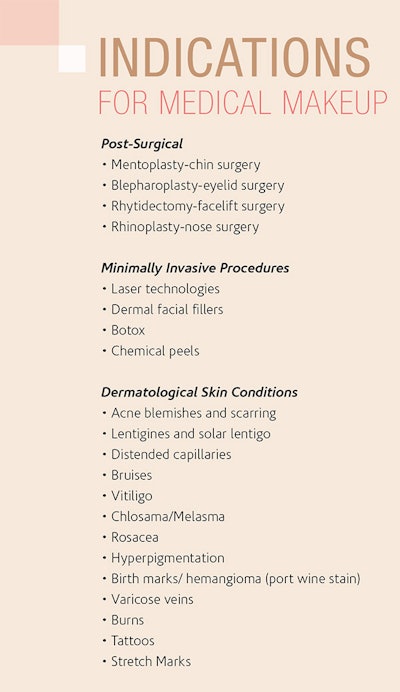
Color theory is based on the principle of “color is light,” with primary colors related to the undertones of the skin. Learning to combine colors successfully is an asset when choosing camouflage shades. Although camouflage makeup is available in a wide variety of shades, it is often necessary to blend colors to arrive at the most appropriate shade to help the client look as natural as possible.
Camouflage makeup should not be confused with cosmetic color correctors—the pastel tinted primers or under bases used with regular cosmetics. Color correctors are a daytime fashion makeup product and are used to alter the undertones of the skin so that the foundation will appear even and smooth. These products do not offer the benefits of camouflage and will not produce the same effect.
Start by determining the client’s skin tone. Is the skin tone sallow, ruddy or gray? If it is sallow or gray, you will need to choose cool colors, with warm colors needed for a ruddy complexion. The best color families are colors that resemble the natural color tones of the skin. Simplify by determining a warm (gold/yellow) or cool (blue/pink) undertone. Place the colors near the face to assess a color match. Test the color match. You many need to blend several colors and adjust as necessary.
Conceal
Analyze the level of discoloration and skin texture to determine which makeup application technique delivers the best possible coverage results. When neutralizing a color issue—bruising such as erythema, birth marks, etc.—apply a color match base on top of the neutralizer color to bring back the normal color of the skin.
Begin by blending with a light layer and then adding layers to build coverage. Additional layers are added with less pressure until the desired coverage is achieved. Be careful not to apply too much pressure when adding layers so as not to lift off material from the previously placed product. This will result in a mask-like effect.
It is not necessary to use the camouflage base all over the entire face. A complimenting lighter textured base may be applied on the rest of the face, blending in to meet the camouflage base.
For the most natural result and to avoid a heavy application, try to achieve a 65–85% correction.
Create
Create utilizing contouring techniques to balance surface defects in the contours of the face and effectively camouflage uneven areas of the skin or any protrusions due to surgery or from some other kind of disfigurement. The goal is to create the illusion of even texture. Light tones will have the effect of making any kind of surface depressions look less apparent and more shallow; whereas dark tones have the ability to diminish the appearance of any kind of swelling or scar tissue-type protrusions.
When creating the illusion of a flat surface area, first cover the scar or protrusion with a camouflage concealer that matches the skin tone of the surrounding skin. Then apply a lighter camouflage color around the inside edge of the protrusion. Set this with powder, and apply a slightly darker shade of camouflage than the skin tone to the area outside the edge of the protrusion and set again with powder.
Setting/Removing Makeup
Do not set the makeup until all of the cosmetics are applied. When you are satisfied with your camouflage application to a specific area, apply a “natural” foundation on the remaining areas of the skin.
Select the proper type of setting powder designed to be used with camouflage makeup. Regular face powders do not contain the binders and agents necessary to hold these types of bases. Camouflage setting powder resembles normal loose face powder with the exception that it contains more binders to set the makeup for a longer period. A powder puff is used to set the makeup with a “pat and roll” application technique.
After the powder has been applied, let it stand for 5 minutes and dust off any excess with a powder brush. If the makeup appears dull, add some color nuances, or touch with a puff dampened with water to “revive” the makeup. If the final makeup appears to be “pasty” or lifeless, a cream rouge or blush may be applied to “warm” the appearance of the foundation. The color tones selected for this are mid-range pale reds and peaches.
Be sure to instruct the patient in proper removal of camouflage makeup. An emulsion-type milky cleanser is best to break down the makeup pigments. The skin may then be cleansed a second time with a lather-type cleanser for a deeper corrective cleanse.





